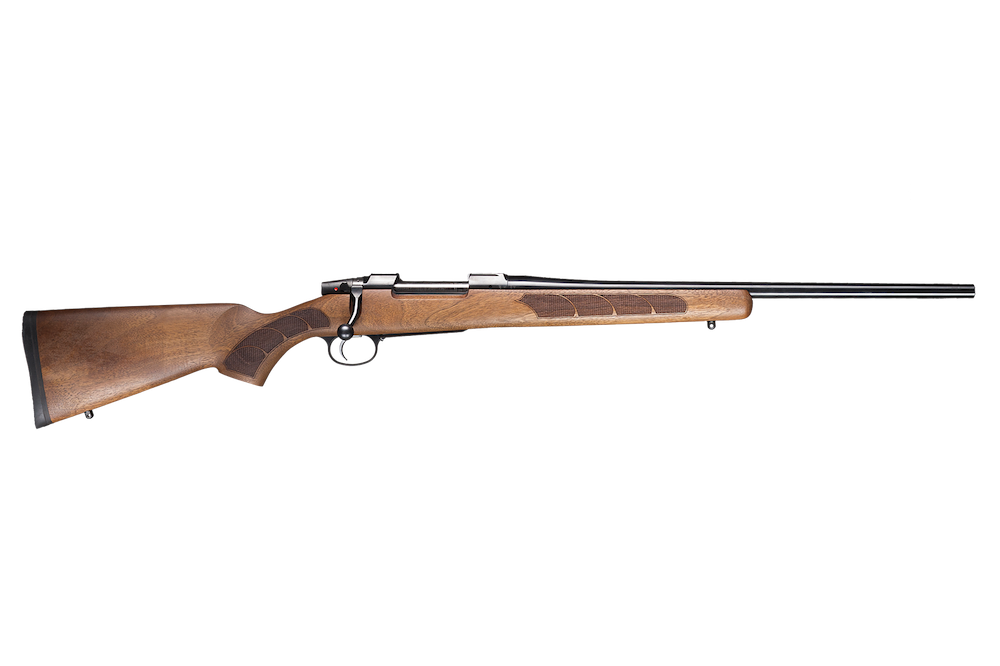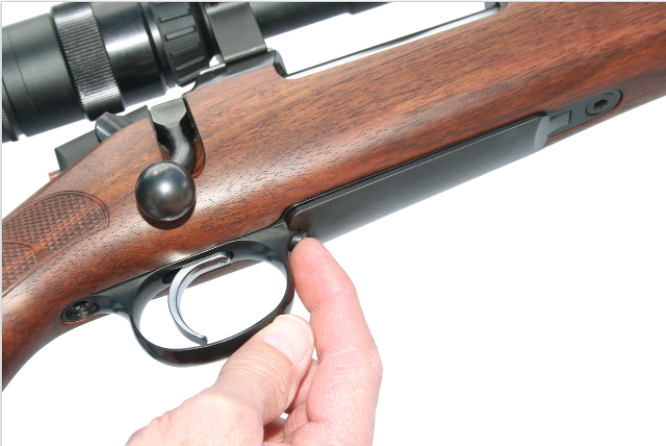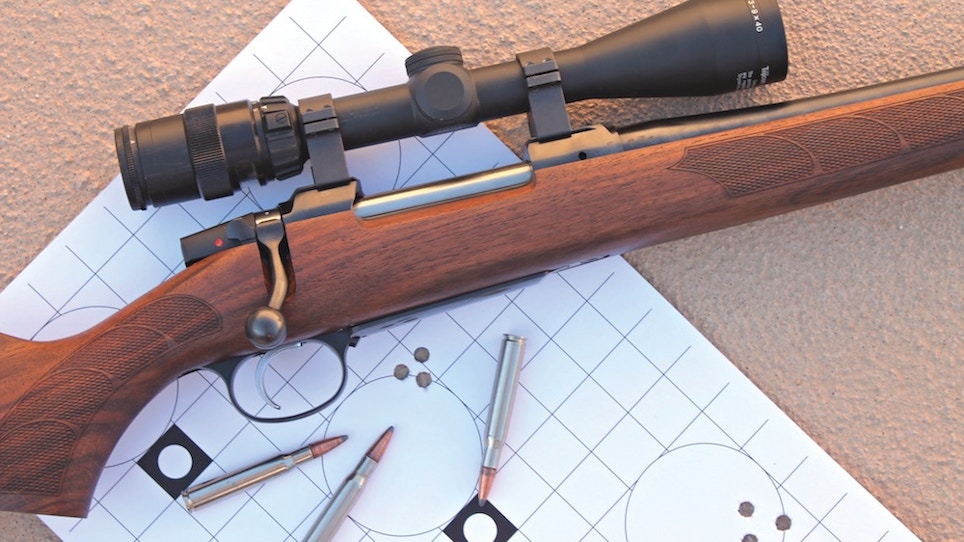With modern sporting rifles and long range chassis guns getting all of the attention lately, it’s easy to forget that there’s a large segment of hunters who still appreciate the warmth of oil-finished walnut and its eye-pleasing contrast when matched up with deep blue steel. I’ll be the first to admit that synthetic stocks combined with stainless or coated steel are the way to go if you want the toughest rifle out there, but what rifles like that have in the way of functional utility, they desperately lack in soul. Without a doubt, synthetic-stocked rifles will endure and be passed down through the generations, but I don’t think they will ever achieve the heirloom status of being revered as “Grandpa’s rifle.”
One rifle that appears destined for such veneration, however, is CZ-USA’s Model 557 Sporter. A gun made using modern methods but with all of the intrinsic qualities of guns made before using plastic on them became common. It’s all blued steel mounted in a walnut stock with precise laser-cut checkering and a satin finish. The only synthetic parts are the solid rubber buttpad and a small bushing around the tail of the firing pin.
“The customer the 557 is designed for is one who wants a best of class deer rifle, but isn’t satisfied with the compromises that have been made on the entry-level priced rifles offered by our competitors,” says CZ-USA’s vice president of marketing Jason Morton.

CZ-USA’s Model 557 Sporter is a gun made using modern methods but with all of the intrinsic qualities of guns made before using plastic became common.
Morton sees those compromises as a cheapening of the products. “It’s possible for us to make a rifle to compete on price with the lowest common denominators in the rifle market,” he says, “but our customers expect a higher quality product from us. Additionally, we take a great deal of pride in our guns. I only want to make rifles I’m proud to carry in the field.”
Morton (and CZ) has every right to be proud of the Model 557. This isn’t an updated version of CZ’s older Model 550. It’s valued for its positive controlled round feed, claw extraction and bombproof Mauser-like action. Instead, it’s an all-new push-feed design with plunger ejector, silky smooth bolt and user-adjustable trigger. “The rifles that are selling in significant numbers lately are push-feed designs,” according to Morton. “For non-dangerous game, there is really no advantage to a controlled round feed action,” he says while also pointing out the possible accuracy advantage of the push-feed platform, how it aligns the cartridge in the chamber and that you can single load. “Have you noticed how there aren’t many controlled round feed Benchrest rifles?” he quips.
While there’s nothing wrong with CZ’s excellent Model 550, with the market changing in favor of push-feed rifles, CZ took the opportunity to not only introduce a new rifle the market wants, but also redesign how it produces them. For example, the older 550 receiver is forged into the basic exterior shape and then machined. CZ contracts out the forging process, causing what Morton described as a “bottleneck” in production.
The Model 557 bypasses the forging step in favor of being fully machined from bar stock — and this is not a simple cylindrical tube turned out with a washer-type recoil lug sandwiched between its face and the barrel like is fashionable today on inexpensive rifles. This action is a complex machining with features such as a flat bottom, integral recoil lug and, as with the 550, CZ’s machined-in 19mm dovetails for mounting a scope.
“It’s a smooth operator,” says Morton of how the bolt glides effortlessly in the receiver. “The tolerances are held very close due to the new CNC machines that are used to make it. You won’t find rough machining or casting marks on this receiver. The accuracy is superb. We invest a lot of time and money in our barrel making and, as a result, no production rifle beats our barrel quality.”
That barrel making includes what CZ refers to as “seasoning.” This stress-relieving process involves leaving the raw barrel stock exposed to the elements for a period of time, and then drilling and reaming before going through the cold hammer forge for rifling and finally lapping. The result is an ultra smooth bore and barrels known for accuracy.
The trigger is quite a contrast from the SST “set” trigger system often found on CZ rifles. With that system, you had a conventional trigger pull, but you could also set it to a hair trigger if you pushed the trigger blade forward. Instead, the 557 comes with a fully adjustable trigger that the owner can tune for pull weight, creep and overtravel. “It’s actually a great trigger,” says Morton, adding that it isn’t as complicated as the single-set trigger system used on the 550 and that it presents a little cost savings that’s passed on to the customer.

Simply pressing a button releases the steel, hinged floorplate for unloading the four-round magazine.
While cost savings was not a primary goal with the 557, others came out of the new design and process without cutting any corners. “Our manufacturing process on the 557 is improved, but not necessarily for cost,” explains Morton. “The overall quality of the rifle has improved. New machines, new steel, new heat-treating — it all comes together to deliver improved quality.”
One of those improvements is the recoil lug and how it beds into the stock. That’s a critical match up when it comes to accuracy, so CZ engineers designed what Morton calls a “recoil lug extension” that provides metal-on-metal contact and distributes recoil over a larger area, yet allows CZ to use smaller bar stock for the action. That smaller bar stock requires less machining, making production less expensive.
Other cost saving features are less subtle — the 557 does not ship with rings. “In the past,” says Morton, “we’ve always included 1-inch med/high rings with our sporter-weight centerfire rifles that didn’t come equipped with iron sights. We made the decision to not include rings with the 557.”
While that may sound miserly of CZ, and I can see where a jaded shooter might get the impression that they want to stick it to you for rings as a separate purchase, the fact is rings aren’t cheap and by including them with the rifle, they add to the cost. “This is an unnecessary cost to every customer who wants to use a 30mm or 34mm scope, or one who wants to use a 1-inch model mounted lower or higher,” says Morton. As much as I love the convenience of the rings coming with the gun, he has a good point.
To see if the 557 performs as well as it looks and if it lives up to Morton’s enthusiasm, I received a loaner chambered in .30-06 Sprg., topped it with a Trijicon AccuPoint 3-9x40mm scope and selected several types of loads to shoot through it. First up was Federal’s 150-grain soft-point Fusion load. This is a nice all-around load for whitetail-size game and turned in and average of 1.18 inch for five consecutive three-shot groups at 100 yards.
Next was Hornady’s comparable American Whitetail that uses a 150-grain Interlock that averaged 1.56 inches. I’ve used that 150-grain Interlock a lot and know it can do better, so I worked up a handload using it with IMR 4064 to the same 2,910 fps as the American Whitetail load and was able to shrink average group size down to 1.03 inches. Three of those groups were less than one inch, and the tightest was a smart 0.52 inch.

Though know for centerfire rifles that have controlled round feed and big claw extractors, CZ turned to the push-feed design for the Model 557.
Regardless of load, the 557 shot the tightest groups with a clean, cold bore. There were no malfunctions of any kind, even when single loading and, as Morton said, this gun truly is a smooth operator. The bolt lifts and glides through the action like it was on ball bearings and the trigger broke at a smart 3.4 pounds pull with no take-up, creep or overtravel.
Recoil from the .30-06 is about the upper limit most hunters will tolerate. The solid rubber recoil pad does a good job of soaking up the kick, and the traditional American-style stock design delivers that recoil straight back instead of rising and jacking your jaw. The 20½-inch barrel is nimble, making the 557 easier to get in and out of blinds or maneuver through heavy cover without sacrificing much in the way of velocity loss.
When it comes to delivering a heirloom-quality rifle, then the CZ Model 557 Sporter appears to deliver. For shooters wanting to pay a little less, there’s a synthetic version, and for those who want a rifle a little lighter there’s a version with a Manner’s carbon fiber stock. “It’s for somebody who doesn’t like where the market has gone,” Morton explains of the ideal Model 557 customer. “It’s somebody who doesn’t like that race to the bottom; the one who doesn’t want the $299 deer rifle.” Customers agree. Michael Hargrove comments that quality and workmanship of the 557 “far exceeds” what he expected considering what he paid. Customer Gary Wright in Alaska calls the accuracy “amazing,” while Dennis J. Natcher says it shoots “everything I put in it at one inch or less at 100 yards.”
The Model 557 rifle also appears to have kicked off some enthusiasm at CZ to see where the limits are with their new manufacturing methods. Morton calls the 557 the “beginning,” and says the company is looking forward to other new and innovative rifle platforms coming down the line.
For more information: www.cz-usa.com
Spec Sheet
Manufacturer: CZ-USA
Model: 557 Sporter
Calibers: .30-06 Sprg., .270 Win., 6.5x55 Swede
Action: Bolt-action repeating rifle
Magazine Capacity: 4
Barrel: 20½-inch hammer forged
Trigger: Fully user adjustable; 3.4 pounds pull
Sights: None. Machined for CZ ring bases sold separately
Stock: Oil-finished Turkish walnut
Overall Length: 41½ inches
Weight: 7½ pounds
Other: Hinged steel floorplate
MSRP: $792
For More Information: www.cz-usa.com






